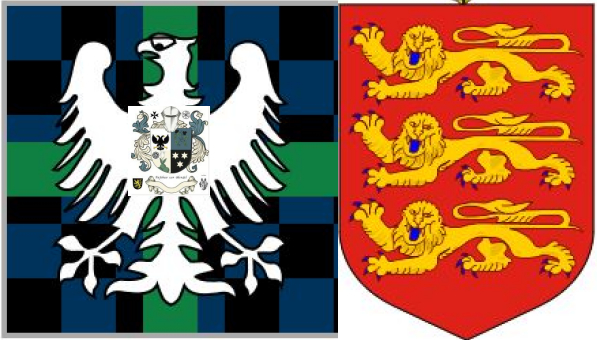


Sark Powers of Fief Seigneur
Sark, like Alderney, developed a constitutional status largely independent of Guernsey but unlike Alderney it did not lose any sovereignty to Guernsey following the Second World War. In the 13th century Sark was a Crown Fief in the care of the Warden of the Isles (the predecessor office to the Lieutenant-Governor of the Bailiwick of today). The Bishop of Coutances had the right to appoint the priest of Sark's church. Justices visited and dispensed justice. The Prevot was the local Judge assisted by Jurats. Sark suffered French invasions during wars between the English and the French. Its population was ravaged by the Black Death of 1348. It is clear that during the 14th century Sark was part of the Bailiwick of Guernsey. Governors exercised shooting rights. If there was a permanent community during some decades of the 14th century it was sparse and lacked any degree of permanency. It is said by Ewan De Carteret in The Fief of Sark that in the 15th century Sark had been abandoned to rabbits and pirates and there was no attempt to resettle it. In July 1549 a substantial French naval force arrived off Sark, 200 men landed and occupied Sark and formed a garrison there. They were further reinforced. As the garrisons in Guernsey and Jersey had insufficient forces to displace them the French remained there. In 1553 Sark was repossessed with the assistance of a Flemish Corsair and then subsequently abandoned. In the early 1560's the English were yet again at War with the French and were worried about the defences in the Channel Islands. Helier de Carteret, the Seigneur of St. Ouen in Jersey proposed that he should be entrusted to populate and defend Sark. The Fiefdom of Sark was granted to Helier de Carteret by Royal Commissions in 1563 and this was confirmed by Queen Elizabeth I in 1565. One of the conditions of the grant was that Sark should be continually inhabited by 40 armed men. Letters Patent of James I in 1612 provided that the 40 tenements (as the land division areas were named) should each remain in undivided ownership. The tenement owners had a seat in Sark's legislative assembly known as the Chief Pleas. This right ceased when the constitution was revised in 2008. The annual rental fee due to the Sovereign for the Fief was payable to the Queen's Receiver in Guernsey. Even to this day an annual nominal sum is paid to Her Majesty's Receiver General in Guernsey by the Seigneur of Sark. The inhabitants soon after the grant by Queen Elizabeth proceeded to elect from amongst themselves a Bailiff and 12 Jurats in imitation of the Courts in Jersey and Guernsey but this was seen in Guernsey as an attempt in effect to set up an administration based on a Jersey system independent of Guernsey. Sir Thomas Leighton, the Governor of Guernsey regarded that as usurpation. A Royal Commission was appointed. It arrived to hear evidence in 1579. The Royal Commission did not agree with Helier de Carteret's intentions and Sark remained within the Bailiwick of Guernsey with the Royal Court of Guernsey as Sark's superior court. However an Order in Council of 1583 established a Court with 5 Jurats, locally chosen by the inhabitants. It was ordained that the Sark Court would have similar powers to that in Alderney. It was further confirmed that appeals would be to the Royal Court in Guernsey as the superior court. The Court could also assemble 3 times each year to sit as a Court of Chief Pleas with a power to make Ordinances. There were some difficulties in the 1600's and in 1672 an Order in Council displaced the Jurats and the Royal Court was given power to appoint the Judge known as the Seneschal but by a further Order in Council in 1685 the power of appointing the Seneschal was vested in the Seigneur of Sark. Sark - The Powers of a Fief SeigneurBy the mid 1800's it is clear that the Seneschal had a very limited criminal jurisdiction to deal with petty offences with a power limited to imposing a small fine. Cases requiring a more severe punishment were dealt with before the Royal Court in Guernsey. The Court of Chief Pleas by the mid 1800's comprised the Seigneur, the Seneschal, the Priest, the Greffier and the Tenants, as owners of the tenements. Ordinances were passed by the Chief Pleas for maintenance of the roads, rates were imposed for the maintenance of the poor and there were ordinance making powers for the purposes of local taxation and police. After Chief Pleas had voted the Seneschal requested the assent of the Seigneur. If the Seigneur withheld his assent then the majority of the Tenants could appeal to the Royal Court of Guernsey. The Royal Court had a limited power to annul an ordinance if it was contrary to superior law. The Chief Pleas also had power to appoint 2 police officers, the Constable being the senior of the two, and the Vingtenier who would succeed him the following year. The Court of Sark, the Seneschal's Court, had an unlimited power to deal with civil cases. Sark's population did not evacuate in June 1940. Its administration and Court functioned throughout the German Occupation and so the state of Sark, following Liberation on 10th May 1945 was totally different to that which confronted Alderney. There had been no significant despoiling and destruction of buildings in Sark. Most of the population had remained. Records had not been lost and title to land and boundaries were clear. The administration and Court had functioned throughout the German Occupation and so had the Chief Pleas, the Island's parliament
Lord Kinnear, in Smith v. Lerwick Harbour Trustees said about the Crown's property rights: "If the solum of Shetland as a whole is not originally the property of the Crown, I know of no authority, and can see no reason, for holding (saying) that part of it which is called the foreshore is Crown Property". This statement could equally well be applied to the seabed, especially since the foreshore is regarded as part of the seabed in English law. S.O.U.L. (udallaw.com) |
Seigneur de la Fief of Blondel Lord Baron Mentz of Fief Blondel Geurnsey Crown Dependency Seigneur Fief of Blondel George Mentz Lord Baron of Fiefdom Blondel Freiherr of Fief Thomas Blondel Feudal Lord of Baronnie - Noble Fief Barony Friherre > Sark Seigneurs and Dames Travel Research Lord Paramount Feudal Barons The Seigneur Order Patron George Mentz Charter of Liberties Deed & Title Fief Blondel Islands Viking Kingdom Fief Worship Fiefs of the Islands ECS Extended Continental Shelf Styles and Dignities Territorial Waters Blondel Privy Seal Fief Bouvees of Fief Thomas Blondel Guernsey Court of Chief Pleas Fief Court Arms Motto Flower Fief de l'Eperon La Genouinne Kingdom of West Francia Fief DuQuemin Bouvée Phlipot Pain Bouvée Torquetil Bouvée Bourgeon Bailiwick of Ennerdale Channel Island History Fief Direct from the Crown A Funny Think Happened On the Way to the Fief Guernsey Bailiwick of Guernsey - Crown Dependency Confederation des Iles Anglo-Normandes Sovereignty Papal Bull Research Links Norse Normandy Order of the Genet Order of the Genet Order of the Star Est. 1022 Knights of theThistle of Bourbon Count of Anjou Fief Rights Blondel and King Richard Press Carnival Manorial Incidents Appointments of Seigneurs Store Portelet Beach Roquaine Bay Neustrasia Columbier Dovecote Fief Blondel Merchandise Fief Blondel Beaches Islands Foreshore Events Fiefs For Sale Sold Lords of Normandy Fief Coin Viscounts de Contentin Fief Blondel Map Feudal Guernsey Titles Board of Trustees The Feudal System Hereditaments Chancellor Flag & Arms Fief Videos Guernsey Castle Sark Contact Advowson Site Map Disclaimer Freiherr Livres de perchage Lord Baron Longford Income Tax Guernsey Valliscaulian Order Saint Benedict of the Celestines Society of Divine Compassion Dictionary Count of Mortain Seigneur de Saint-Sauveur Seigneur of Fief Ansquetil Top Success Books Datuk Seri George Mentz Order St. Benedict OSB Celestines Order of the Iron Crown Order of the White Falcon Colonel Mentz Order Red Eagle Order St. Louis Order Holy Ghost Order of Saint Anthony Order of the Black Swan Order of St Columban Order of the Iron Helmet Livonian Brothers of the Sword Fief treizième and Direct from Crown Valuation Fief Blondel Prince of Annaly Teffia
Feudal Lord of the Fief Blondel of the Nordic Channel Islands Guernsey Est.
1179
Feudalherr - Fief Blondel von der Nordischen Insel Guernsey Est. 1179
New York Gazette - Magazine of Wall Street -
George Mentz -
George Mentz - Aspen Commission - Mentz Arms
Counselor George Mentz Esq. - Seigneur Feif BlondelBaron Annaly Baron Moyashel Grants to Delvin About Longford Styles and Dignities The Seigneur Court Barons Fiefs of the Islands Longford Map The Island Lords Market & Fair Fief Worship Channel Island History Fief Blondel Lord Baron Longford Fief Rights Fief Blondel Merchandise Events Blondel and King Richard Fief Coin Feudal Guernsey Titles The Feudal System Flag & Arms Castle Site Map Disclaimer Blondel Myth DictionaryMentz Scholarship Program 101 Million Donation - Order of the Genet Knighthood |





George Mentz Education -
Commissioner George Mentz
-
https://finance.yahoo.com/news/commissioner-george-mentz-clinches-influencer-180000705.html
-
George Mentz News -
George Mentz Net Worth - George Mentz Noble Tilte -
George Mentz -
George Mentz Trump Commissioner -
George Mentz Freiherren Count Baron -
George Mentz Global Economic Forum -
George Mentz Donates Millions